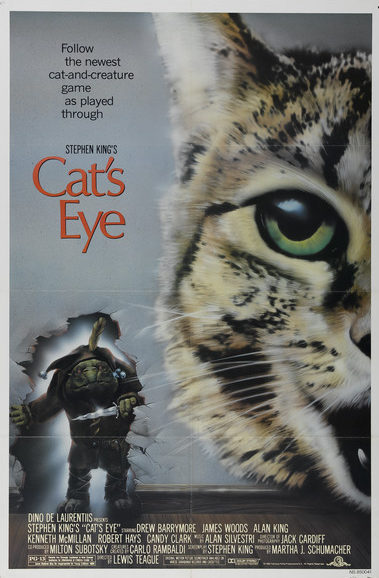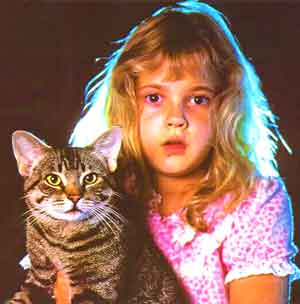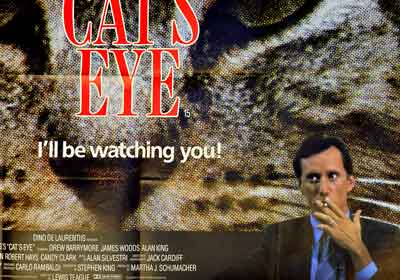 This 1984 Dino de Laurentiis production is said to have been the second movie (following RED DAWN) to be given the then-novel PG-13 rating. That’s not entirely true (seeing as how CAT’S EYE wasn’t released until April of 1985, having been beaten to the punch by the PG-13 rated Rob Lowe vehicle OXFORD BLUES, which premiered a mere two weeks after RED DAWN), but that rating encompasses the film’s primary flaw: it’s too watered-down, whereas its screenwriter Stephen King and director Lewis Teague tend to go down best in R-rated form.
This 1984 Dino de Laurentiis production is said to have been the second movie (following RED DAWN) to be given the then-novel PG-13 rating. That’s not entirely true (seeing as how CAT’S EYE wasn’t released until April of 1985, having been beaten to the punch by the PG-13 rated Rob Lowe vehicle OXFORD BLUES, which premiered a mere two weeks after RED DAWN), but that rating encompasses the film’s primary flaw: it’s too watered-down, whereas its screenwriter Stephen King and director Lewis Teague tend to go down best in R-rated form.
King’s assignment was to write a starring vehicle for the then-nine year old Drew Barrymore (six months after she headlined the King-adapted FIRESTARTER). Like the King scripted CREEPSHOW, CAT’S EYE was an anthology project, with three segments (two of them adapted from King stories) linked by the exploits of a stray cat. Filming took place at de Laurentiis’ studios in Wilmington, North Carolina, under the direction of the usually reliable Teague (coming off CUJO).
King’s assignment was to write a starring vehicle for the then-nine year old Drew Barrymore…
A prologue was allegedly filmed that showed the connection between Barrymore and the cat of the title, but that segment was discarded. Thus we’re never informed why it is that the cat is so anxious to get to her, outside a cryptic early scene in which the cat catches sight of a TV monitor on which a girl who looks like Drew Barrymore calls for it to come save her.
From there the cat is captured by some big city goons from an outfit called Quitter’s, Inc. (in an account inspired by King’s similarly titled 1978 story). The organization, led by a highly ominous fellow (Allan King), is undeniably shady, but an upper middle class man (James Woods) looking to quit smoking signs on to their program. First he’s forced to watch as the cat is tortured by being put in a glass room with an electrified floor, and then he has to deal with having his every move monitored to make sure he doesn’t smoke; when Woods breaks down and lights up a cigarette in the midst of a traffic jam his wife is kidnapped and forced to undergo what the cat did. This leads Woods to clean up his act for good (in a finale that would be effective were it not so similar to the final page of the Roald Dahl story “Man from the South”—adapted, FYI, for a 1960 episode of ALFRED HITCHOCK PRESENTS and the Quentin Tarantino helmed segment of 1995’s FOUR ROOMS).
A prologue was allegedly filmed that showed the connection between Barrymore and the cat of the title, but that segment was discarded. Thus we’re never informed why it is that the cat is so anxious to get to her…
In part two the cat, having escaped the clutches of the Quitters Inc. folk, stows away aboard a cargo ship that deposits it in Atlantic City. Here the critter is captured by a sleazy gangster (Kenneth McMillan), who cons a gambler (Robert Hays) into a “bet” that involves scaling the ultra-thin railing along the upper floor of a high-rise, in a segment adapted from King’s 1976 story “The Ledge.”
The cat bolts once again and ends up in North Carolina, where the little girl for which it’s been searching resides. The girl, we learn, is haunted by a troll that lives in her bedroom wall, and is looking to steal her breath from her mouth. The determined cat, named “General” by the girl, is rebuffed by her mother (Candy Clark) and sent to the local pound, but it breaks out and runs back to the house, to take on the troll in a confrontation only one of the two will survive (I wouldn’t dream of revealing who).
 Film-making-wise CAT’S EYE is marred by a staid and static TV movie-ish treatment (which explains why the film was more successful on VHS than it was in theatrical release) that Teague, known for vibrant low budget features like THE LADY IN RED (1979), ALLIGATOR (1980) and FIGHTING BACK (1982), blamed on cinematographer Jack Cardiff. Teague did nonetheless turn out a fairly memorable piece of PG-rated nastiness with the “Quitter’s, Inc.” segment, which is enhanced by a typically manic central performance by James Woods, who’s quite convincing as an on-edge smoker. Less successful is “The Ledge” segment, which is marred by overwrought and implausible attempts at suspense (including a falling sign and peck-happy pigeon), while the final segment might have played fine if it weren’t so damn similar in conception and execution to the classic Richard Matheson story “Prey” (and its adaptation in the “Amelia” portion of TRILOGY OF TERROR).
Film-making-wise CAT’S EYE is marred by a staid and static TV movie-ish treatment (which explains why the film was more successful on VHS than it was in theatrical release) that Teague, known for vibrant low budget features like THE LADY IN RED (1979), ALLIGATOR (1980) and FIGHTING BACK (1982), blamed on cinematographer Jack Cardiff. Teague did nonetheless turn out a fairly memorable piece of PG-rated nastiness with the “Quitter’s, Inc.” segment, which is enhanced by a typically manic central performance by James Woods, who’s quite convincing as an on-edge smoker. Less successful is “The Ledge” segment, which is marred by overwrought and implausible attempts at suspense (including a falling sign and peck-happy pigeon), while the final segment might have played fine if it weren’t so damn similar in conception and execution to the classic Richard Matheson story “Prey” (and its adaptation in the “Amelia” portion of TRILOGY OF TERROR).
…a fairly memorable piece of PG-rated nastiness with the “Quitter’s, Inc.” segment, which is enhanced by a typically manic central performance by James Woods…
Another complaint: the quasi-comedic tone, which results in an avalanche of cutesy Stephen King references such as a cameo by Cujo (played, Teague claims, by one of that film’s canine performers) and another by Christine the haunted car, scenes of Woods watching THE DEAD ZONE (1983) and Clark reading PET SEMATARY, a boarding school named “Saint Stephen,” etc. Teague, a filmmaker who, in King’s words, “just wants to get ya,” isn’t great with the type of playful PG rated comedy attempted here. His specialty is the scary stuff, of which CAT’S EYE contains far too little.
Vital Statistics
CAT’S EYE
Dino De Laurentiis Company/Famous Films
Director: Lewis Teague
Producers: Dino de Laurentiis, Martha Schumacher
Screenplay: Stephen King
Cinematography: Jack Cardiff
Editing: Scott Conrad
Cast: Drew Barrymore, James Woods, Alan King, Kenneth McMillan, Robert Hays, Candy Clark, James Naughton, Tony Munafo, Court Miller, Russell Horton, Patricia Benson, Mary D’Arcy, James Rebhorn, Jack Dillon, Susan Hawes, Shelly Burch, Sal Richards, Jesse Doran, Charles S. Dutton

